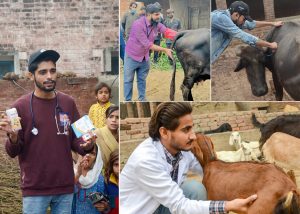
By Rehma Ali
The recent incidences of transmission of the avian influenza A(H5N1) virus in dairy cows and humans getting infected from these cattle is a cause of serious concerns, bringing the risk of outbreaks of zoonotic diseases in the spotlight, especially for the farming communities.
The current multistate outbreak of highly pathogenic avian influenza (HPAI) is not only notable for its novelty but also for its potential implications for both animal and human health.
The Centers for Disease Control and Prevention (CDC) has confirmed the detection of the avian influenza A(H5N1) virus in dairy cows, which is first incidence of detection of this virus in mammals.
There have also been reported cases of human infections linked to this outbreak. While human infections with HPAI are not new, the transmission from dairy cows to humans represents a new development in zoonotic disease history.
The outbreak, first identified by the USDA’s Animal and Plant Health Inspection Service on March 25, has since affected dairy herds across 12 states: Texas, Kansas, Michigan, New Mexico, Idaho, Ohio, North Carolina, South Dakota, Colorado, Minnesota, Wyoming, and Iowa. All the 12 states have confirmed cases of HPAI in dairy cattle.
According to the World Health Organization (WHO), zoonotic diseases can spread through direct contact with infected animals or indirectly through contaminated environments. They may also be transmitted by vectors, contaminated food, or water.
Certain populations, including young children, the elderly, individuals with weakened immune systems, and pregnant women, are at higher risk of zoonotic diseases. Historical records indicate that zoonotic diseases have been acknowledged since the 19th century, with the term “zoonosis” introduced by Rudolf Virchow. Today, these diseases are more prevalent than ever.
Mohamed Shaheen, an associate professor of microbiology at the National Research Centre in Cairo, highlights that 60% of known infectious diseases in humans originated in animals, and 75% of emerging infectious diseases globally are zoonotic.
The impact of zoonotic diseases on agriculture is profound, affecting both animal health and farm productivity. For example, the recent HPAI outbreak led to a significant reduction in milk production, with affected herds seeing declines of up to 20pc.
The economic ramifications are substantial, as research from the China Academy for Rural Development reveals that zoonotic diseases have negatively impacted nearly all major farm commodities in China from 2002 to 2017.
To reduce the risk of zoonotic disease transmission, the CDC recommends several preventive measures. It is essential to wash hands thoroughly after contact with animals and avoid bites from mosquitoes, ticks, and fleas. Handling food safely and being aware of zoonotic risks at home and during travel are also crucial. Additionally, preventing animal bites and scratches can help minimize risk.
The AgriSafe Network provides additional strategies specifically tailored for farms. These include using appropriate personal protective equipment (PPE) and designating specific work clothes, along with disinfecting work areas. Farms should provide a handwashing station for workers and ensure they wear sturdy shoes, long pants, and insect repellent. Workers should inspect for cuts or bites daily and treat any open wounds before interacting with animals. It is also important to keep medical records up-to-date, including tetanus vaccinations.
Effective communication and education among farmers and farm workers are crucial for preventing the spread of zoonotic diseases. By understanding disease transmission and building a cohesive response team, the risk can be significantly reduced.
As zoonotic diseases become more prevalent, it is vital for the farming community to remain vigilant. By implementing robust preventive measures and promoting a culture of education and preparedness, farmers can better protect their health and productivity against these emerging threats.







